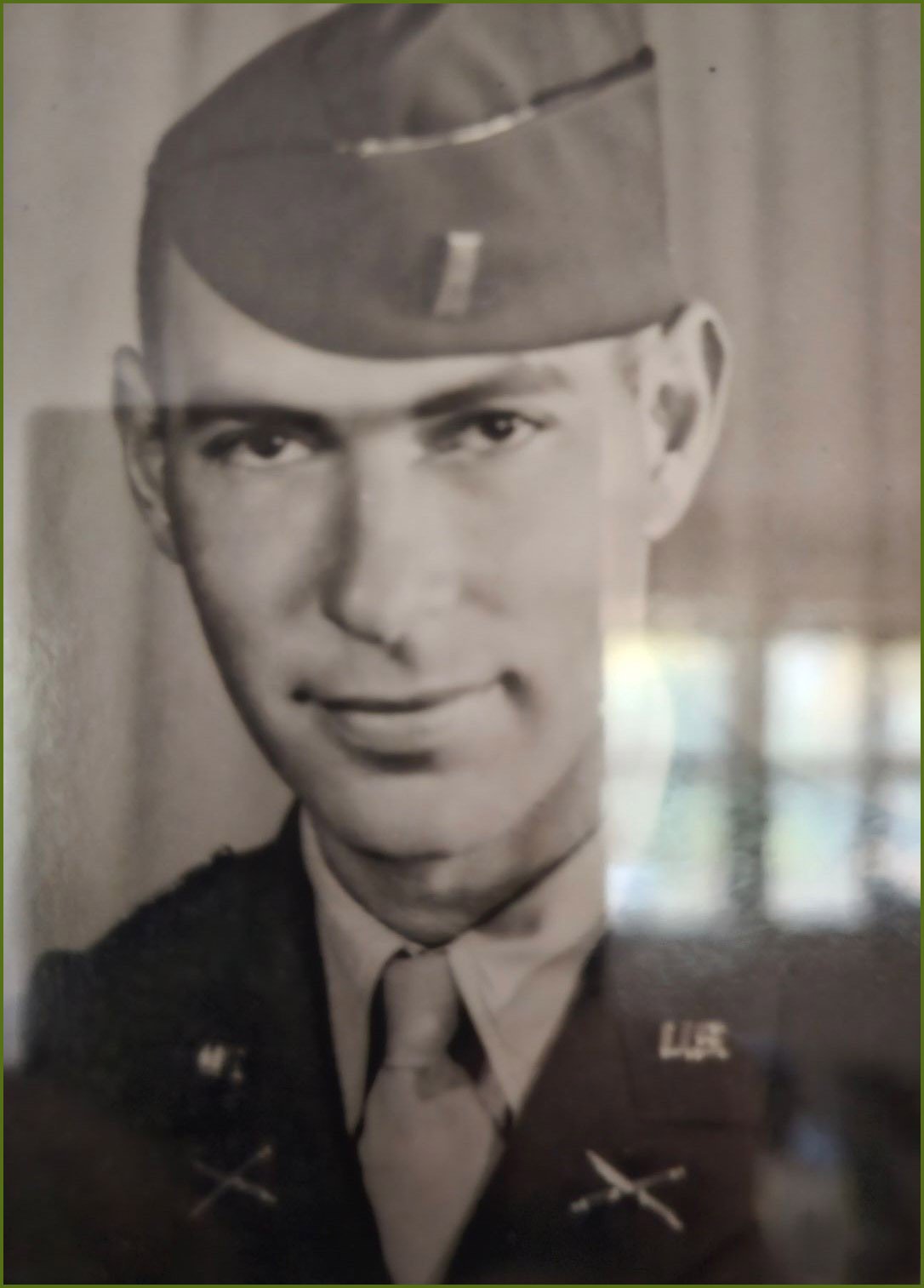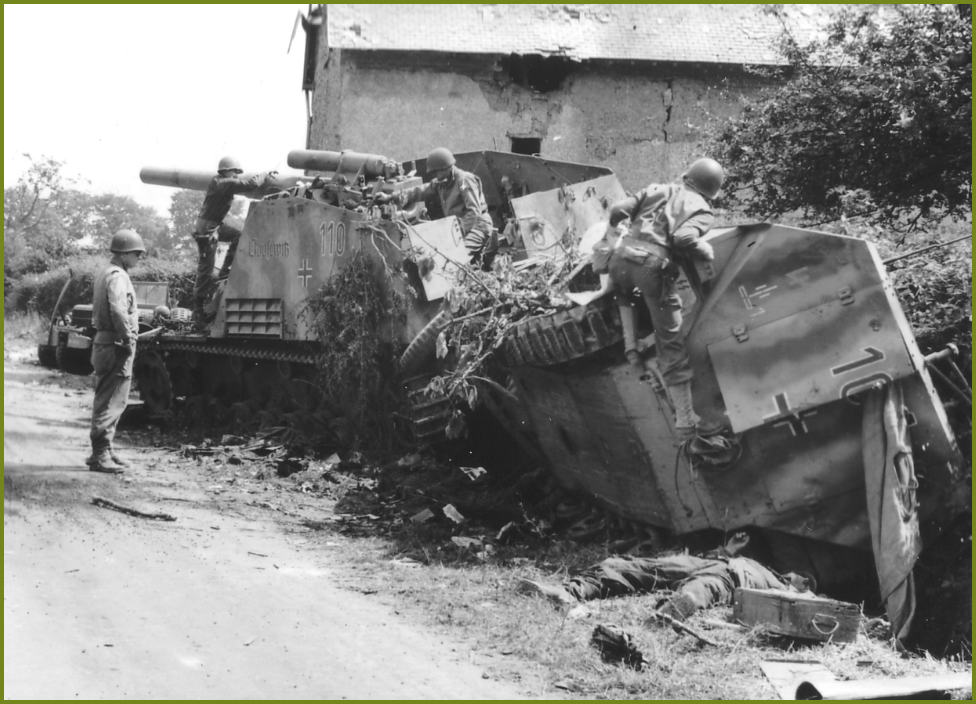On July 29th at 0655pm, the 78th Armored Field Artillery Battalion of the 2nd Armored Division took a position near La Chapelle du Pont Flaba at coordinates 291441 (see map below). The Fire Direction Centre was in a little V-shaped sunken road on the south of the main road and “B” Battery was just on the other side.
 ©2023IGNMap - Remonterletemps.com
©2023IGNMap - Remonterletemps.com
All afternoon and since the battalion settled in the area, the enemy did not stop harassing the entire unit. However, at 0200am during the night of the 29th to the 30th of July, the attack became serious. German infantry tried to infiltrate “B” Battery’s position. “B” Battery’s outpost replied by opening fire. Several Germans were killed or wounded and five were taken prisoners. At 0215am, Captain Naubert O. Simard Jr., Battalion S-2, took the prisoners across the road from the command post and started interrogating them (see map below)
M-10 tank destroyers of the 702nd Tank Battalion, M-7s of the 78th Armored Field Artillery Battalion are moving out for the attack in the breakthrough in Normandy on July 26th,1944.©Combatreels.com
Then Lieutenant Veenstra (AAR Spelling) the 67th Armored Regiment's Reconnaissance Company, arrived in a rush at the command post and alerted the 78th Armored Field Artillery Battalion’s Commander, Lieutenant-Colonel Hugh M. Exton, that his unit had to leave their outpost at Saint-Denis-le-Gast because the enemy was coming in full force. Indeed, while he was assembling his column ready to leave the place, he heard German voices coming from an American half-track. It seems that a German column had annexed itself to an American one!
Major Harold G. Maynard, 78th Armored Field Artillery Battalion Executive Officer, just had the time to contact by radio the Combat Command “B” (Brigadier General Isaac D. White C.O of CCB) to tell them that the roadblock in Saint-Denis-le-Gast was out. In the meantime, a damaged M-10 from “C” Company of the 702nd Tank Destroyer Battalion swept in the area taking up positions near the battalion’s command post. One of his motors had been knocked out by an enemy’s mortar fire a little bit earlier on the road from Saint-Denis-le-Gast to Lengronne.
 This map shows the positions of the 78th Field Artillery Battalion during the German counterattack.
This map shows the positions of the 78th Field Artillery Battalion during the German counterattack.
Almost at the same time, an armored column appeared. Captain Simard who had been questioning the prisoners along the road yelled that the column was German! After a moment of hesitation and the exchange of a few words, chaos broke out! Everybody opened fire. All the batteries were alerted that the column was German. “A” Battery succeeded knocking down the leading vehicle of the enemy column, a Mark IV Special Tank towing an 88mm gun, firing a total of thirty-seven rounds. “B” Battery was directed to fire broadside and the headquarters battery opened with their 50mm caliber machine guns. The M-10 from the 702nd also did his part by firing twenty-eight rounds at the rear of the column. At last, the Germans were overwhelmed by all this intense fire.
 ©Robert Hammond Jr - Captain Robert M. Hammond 78th Field Artillery Battalion. Captain Hammond experienced the battle of Lengronne along D-13 on the night of the 29th to the 30th of July.
©Robert Hammond Jr - Captain Robert M. Hammond 78th Field Artillery Battalion. Captain Hammond experienced the battle of Lengronne along D-13 on the night of the 29th to the 30th of July.
Unfortunately, Captain Naubert Simard was severely injured during the battle while he was manning his 50mm caliber machine gun on his half-track and died few hours later. Lieutenant-Colonel Exton was wounded as well but it was in the upper leg, he got some first aid and then continued to direct the operations for the defense of the area.
At 0430am, two 78th Armored Field Artillery Battalion forward observers, Lieutenant Richard C. Moses and Lieutenant George R. Bennett reported the presence of about a hundred enemy vehicles along the Grimesnil road. Captain Walter C. Johnson (“I” Company, 3rd Battalion, 41st Armored Infantry Regiment) and Captain James R. McCartney (“E” Company, 2nd Battalion, 67th Armored Regiment) needed help defending the road. In fact, they have been calling for artillery support for about an hour or so. Captain John M. Hart, 78th's Battalion S-3, argued: “Those boys are screaming and begging for fire up there”.
Despite the order issued by Premium Combat Command “B” requiring clearance before any indirect fire could be delivered (friendly troops were in the area), Major Harold G. Maynard finally ordered the 78th and the 62nd Armored Field Artillery Battalions to start firing in direction of the Grimesnil road and the battle lasted all night. However, by 0730am on July 30th, almost all firing had stopped.
The total losses for the 78th Armored Field Artillery Battalion were five killed and six wounded. The entire German column was destroyed, apparently it was the Reconnaissance Units of the Headquarters of the 2nd SS Panzer Division. Moreover, one hundred ninety-seven were taken prisoners.
 American soldiers inspecting wrecked German armored cars along the Grimesnil road.
American soldiers inspecting wrecked German armored cars along the Grimesnil road.
Note: Patrick Fissot owner of the Normandy Victory Museum met a soldier of the 238th Engineer Combat Battalion of the 2nd Armored Division who fought at La Lande des Morts. Patrick will always remember words from that soldier regarding the supporting fire of the 78th and 62nd Armored Field Artillery Battalions: " A shell doesn’t make the difference between an American and a German helmet”.

















